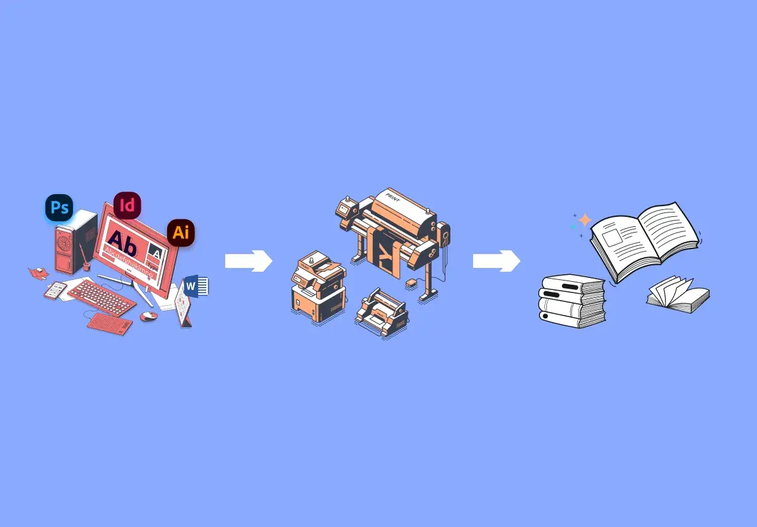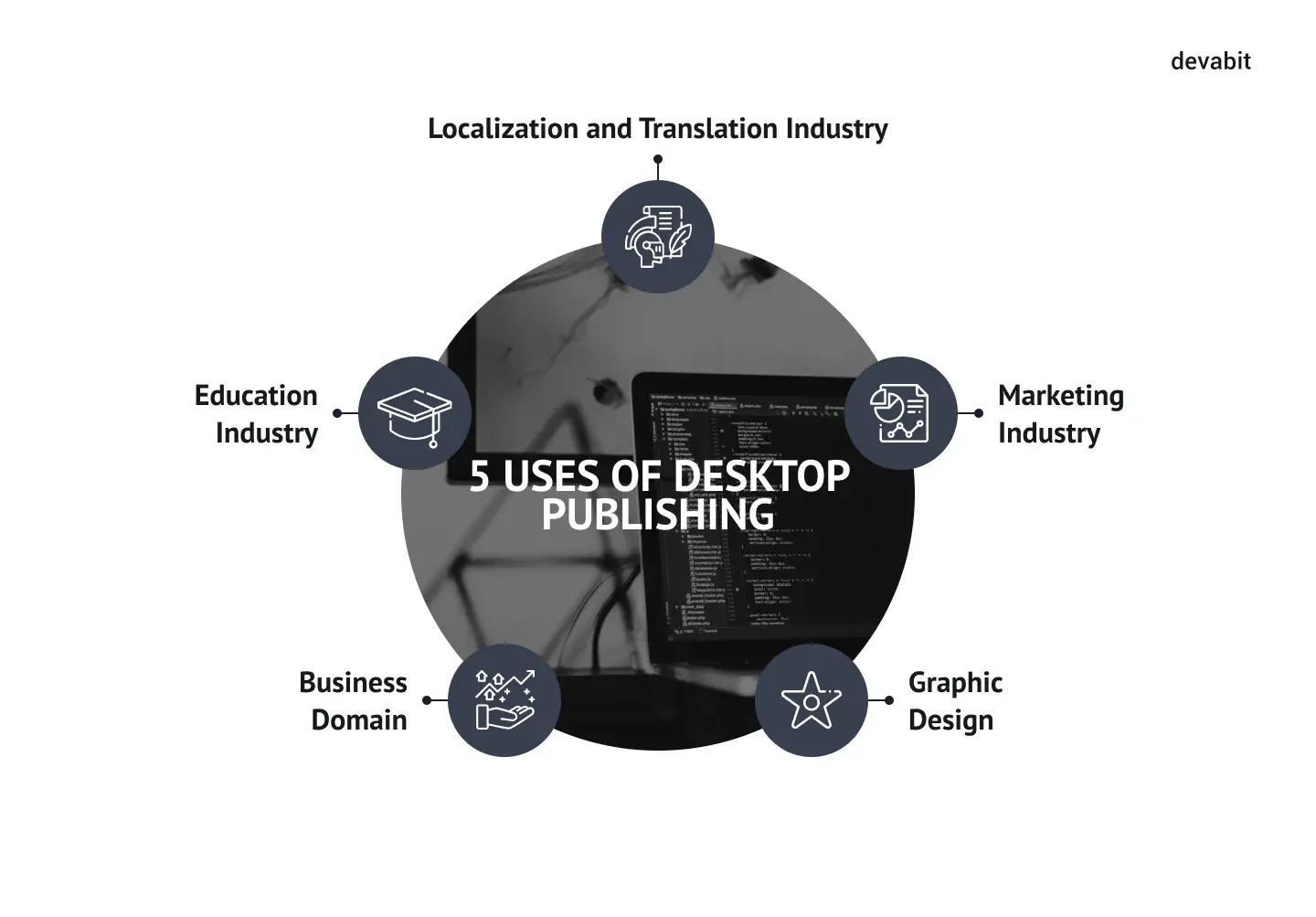5 Uses of Desktop Publishing: Industries Where It Is Absolutely Essential
Back in the '80s, when the uses of desktop publishing were at their dawn, the whole industry served to assist graphic designers. Desktop publishing (DTP) specialists worked on transitioning mechanical layouts into digital files. Nowadays, the role and expertise of DTP professionals have radically extended. Desktop publishing services have evolved significantly, with countless industries now embracing the uses of desktop publishing to improve their workflows. Not only is desktop publishing used in education, marketing, and web design, but it also brings many benefits to the translation and localization industry, the marketing sector, and even the business domain. Yet, why has DTP become so popular? And how will DTP shape the landscape of the upcoming year? These and many more questions we are going to answer in today's article, revealing the top 5 uses of desktop publishing in 2026 and beyond.
In short, today we will explore the following topics:
- Desktop Publishing Services refer to the creation and layout of visual documents using specialized software, such as Adobe InDesign, QuarkXPress, or Microsoft Publisher. These services are designed to produce printed materials, digital documents, and web content with professional-quality formatting, design, and typography.
- The top 5 uses of desktop publishing in 2026 include:
- Localization & Translation Industry
- Marketing Industry
- Education Industry
- Business Domain
- Graphic Design
- How can my business benefit from desktop publishing outsourcing? Outsourcing Desktop Publishing (DTP) can offer numerous advantages for businesses, including:
- Cost Savings;
- Access to Expertise;
- Time Efficiency;
- Scalability and Flexibility;
- Faster Turnaround Times;
- Consistency and Professionalism.
- Common applications of DTP include:
- Brochures;
- Magazines and newspapers;
- Books and eBooks;
- Flyers, posters, and advertisements;
- Annual reports, newsletters, and catalogs.
Ready for more Desktop Publishing insights? Go right below!

How the Application of Desktop Publishing Has Changed through the Years
Even though DTP was initially created for printed materials, the emergence of digital technologies and the mind-blowing popularity of the World Wide Web have drastically changed the way DTP can be applied. Hence, global digitalization brought along many of the same design issues that graphic artists experience in print.
At the same time, whether you are creating a presentation, newsletter, website content, or any other piece of text, it is essential to understand how to adjust the design elements for optimal readability in the target language. This includes knowing when to move specific words to a new line to avoid incorrect breaks, selecting appropriate images and color schemes to avoid cultural misunderstandings, and revising the document's layout to suit the new medium.
Fortunately, here desktop publishing services also come for help. Considering all of the above, it is clear that DTP is not limited to the confines of graphic designers who look at how to make web and print material pretty. In fact, the modern application of desktop publishing goes far beyond the simple production of page designs with your computer, and we are going to prove it in the following paragraphs.
Top 5 Uses of Desktop Publishing in 2026 and Beyond

01 / Uses of Desktop Publishing in the Localization & Translation Industry
When it comes to the top 5 uses of desktop publishing, the localization and translation industry takes the first place for a good reason. That is because the volume of translated texts frequently differs by up to 40% compared to the original. The localization and translation industry is one of the key 5 uses of desktop publishing today.
This includes the length of words and lines, writing direction, punctuation, etc. Such differences can negatively impact the overall document appearance unless managed carefully and correctly. Desktop publishing experts can format translated text to resemble its original look as much as possible. Besides, various illustrative statistics elements such as tables, charts, and diagrams feature intricate labels, captions, and measurement units.
As for the 5 uses of desktop publishing in the localization and translation industry, it is critical for ensuring that translated text is formatted properly and fits within the design constraints of the original content. Adequate and accurate localization of these elements is essential for effective communication. With requisite linguistic resources, DTP specialists ensure text placement is correct while linguistic conventions remain respected.

02 / Uses of Desktop Publishing in the Marketing Industry
The 5 uses of desktop publishing extend beyond the creation of visually appealing content. Nowadays, the uses of desktop publishing are no longer exclusive to graphic designers. In marketing, the uses of desktop publishing have expanded beyond traditional print to include digital formats.
For example, in the marketing routine, DTP tools are used to handle all the 'paperwork.' Therefore, employees who have little in common with graphic design jobs often install and use DTP software. Marketers create visual and digital communication materials, such as webpages, newsletters, leaflets, etc., on a daily basis. Thanks to such an application of desktop publishing, what was once put in the hands of design studios or in-house design departments is now quickly and effectively handled, thanks to desktop publishing.

03 / Uses of Desktop Publishing in the Education Industry
The uses of desktop publishing in education cannot be understated. In the education sphere, both teachers and students create a variety of presentations, home assignments, and projects using DTP tools. Desktop publishing skillset involves using a computer to produce attractive layouts and communicate ideas and messages more effectively.
Students can learn basic DTP skills to improve the look and clarity of their papers. For instance, teachers might illustrate a story for children or create a newsletter for teenagers, while students can design a biographical presentation about some significant historical figures. As a result, learning becomes more personal, illustrative, and meaningful when students create publications for a large target audience. This shift reflects the growing uses of desktop publishing in academic settings.

04 / Uses of Desktop Publishing in the Business Domain
As much as skilled designers use desktop publishing, so do small business owners. One can rarely find an office that does not produce any kind of publishing materials in-house. And today, it is not necessary to hire professional designers and use commercial printers.
In the business domain, the uses of desktop publishing are widespread, from small business owners creating flyers to large corporations designing internal reports. In the office environment, word processing is one of the foremost parts of the desktop publishing skillset. This means a minimum familiarity with the Microsoft Office Suite or Publisher.
Office managers, salespeople, and HR assistants all handle various aspects of DTP. The ability to work with the page layout or word processing is a desirable skill for many employees. For example, an HR manager who can design an onboarding form for newcomers, a salesperson who can format reports or direct mail templates, and a resource manager who can deliver a ready-for-use handbook. Moreover, popular uses of desktop publishing often refer to building a slideshow, creating a business card, or preparing legal documentation.

05 / Uses of Desktop Publishing in Graphic Design
Advertising agencies, publishing, color separation, printing, and other related industries are all known for the uses of desktop publishing. DTP artists are usually responsible for translating graphic designers' work into digital, ready-to-go files for printing or digital publishing.
Thanks to everyday uses of desktop publishing, graphic design has become more than just a pencil and a pen. The uses of desktop publishing include everything from designing brochures to preparing files for print. While desktop publishers are generally not designers, without DTP, there is no graphic design and vice versa.
However, only some DTP specialists can do design, but every designer can perform DTP tasks. Designers mainly use DTP programs such as QuarkXPress, Adobe PageMaker, and Adobe Photoshop. Read more about the best DTP software in our recent article about 8 popular desktop publishing software examples in 2026.

How the Application of Desktop Publishing Can Benefit Your Business
Since we have already analyzed the top 5 uses of desktop publishing, let us define the advantages DTP may bring to your unique business. Keeping up with the latest trends and meeting customer expectations requires more than just relying on basic word-processing tools.
More than that, each time you need to create a brochure or a web advertisement for your marketing campaign, it could be more efficient in terms of both budget and time consumption to reach out to third-party business process outsourcing (BPO) vendors. Instead of engaging in-house DTP experts, it would be better to explore the opportunities DTP outsourcing provides.

Vast Customization Capabilities
Speaking of the top 5 uses of desktop publishing software, smooth customization is the first rocking benefit that comes to mind. Whether you want to design a brochure, envelope, menu, or marketing advertisement, you can adjust every file to your preferences without spending lots of time and effort.
Lower Costs
Outsourcing DTP services does not require any extra investment since you do not have to pay for equipment, software, or regular upgrades. Hence, if you consider outsourcing the uses of desktop publishing as your option, production costs can be significantly minimized.
Next-Gen Productivity
Needless to say, uses of desktop publishing can significantly enhance the production rate. Thanks to its advanced cutting-edge technology and easy-to-use tools, DTP reduces the time you spend creating and managing the design of a document.
Simplified Publishing
Nearly all DTP applications offer the option to switch between RGB and CMYK color palettes, ensuring that the vibrancy and luminosity of your design are maintained. Moreover, by adjusting the bleeds, you can guarantee that the number and quality of elements in the file match up before as well as after publication.
High-Quality Content
Whether you utilize DTP for translation or simply create various types of digital documents, the arrangement of the graphics or texts on a given page is always perfect when it comes to our top 5 uses of desktop publishing.
Final Verdict on 5 Uses of Desktop Publishing
As the demand for efficient document design increases, understanding the 5 uses of desktop publishing can be a game-changer. Did you find your industry in the list of the top 5 uses of desktop publishing? Well, it seems like a life-changing sign to outsource your DTP needs in 2026. In addition to desktop publishing services, devabit also provides dedicated remote teams, so you can easily scale a team of PHP, iOS, Android, or Vue.js developers per your request.
The 5 uses of desktop publishing outlined in this article demonstrate how integral DTP has become across various industries. Luckily, our desktop publishing team has over a decade of accumulated experience in multiple localization and translation projects. Over time, we have delivered many successful multilingual DTP projects. We would be glad to partner with your company and deliver high-quality, ready-for-use documents. For more information about the uses of desktop publishing software in your industry, contact us to see how we can help you streamline your document production and design processes.
Recent Publications
Don't miss out! Click here to stay in touch.
Discover More

Relevant Articles View all categories
View all categories CONNECT WITH US WE’RE READY
TO TALK OPPORTUNITIES
THANK YOU! WE RECEIVED YOUR MESSAGE.
Sorry
something went wrong



